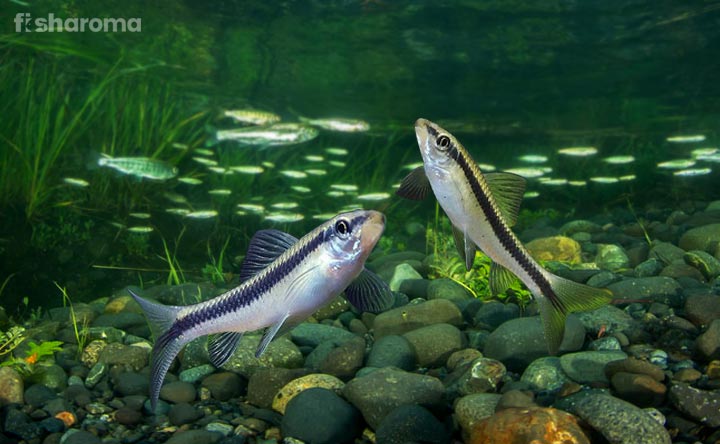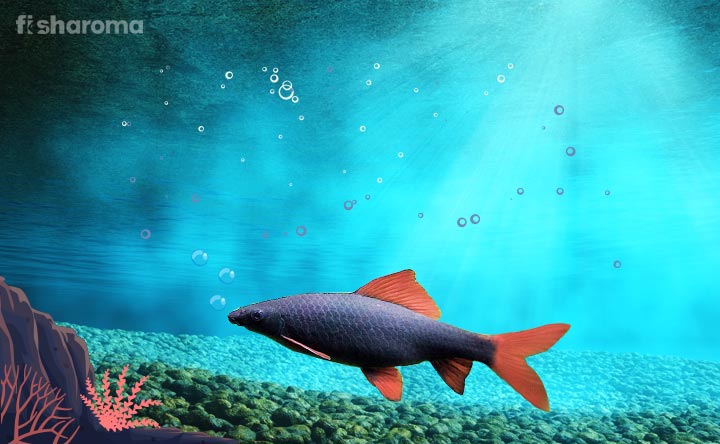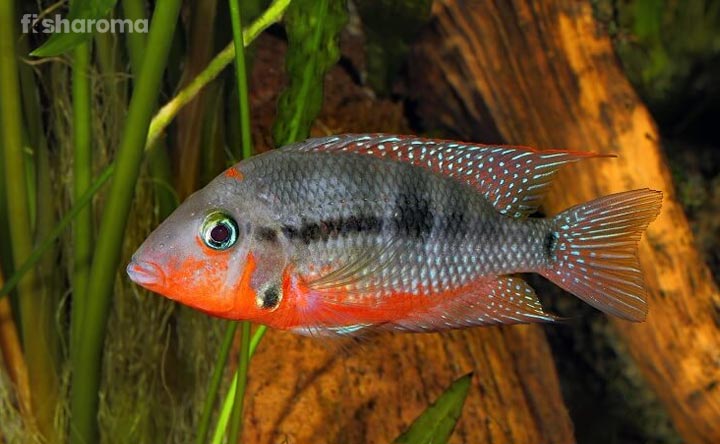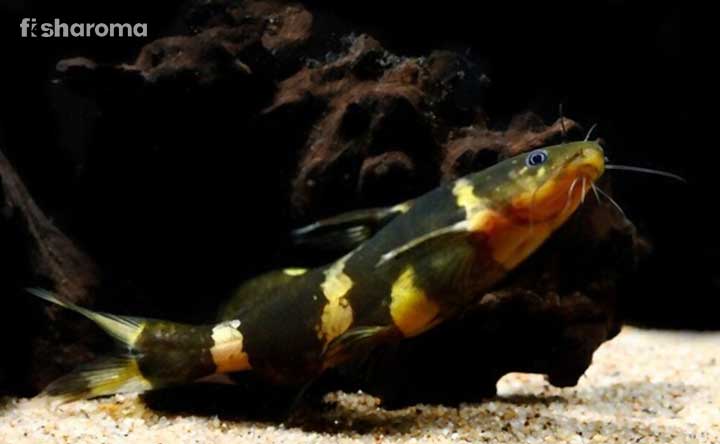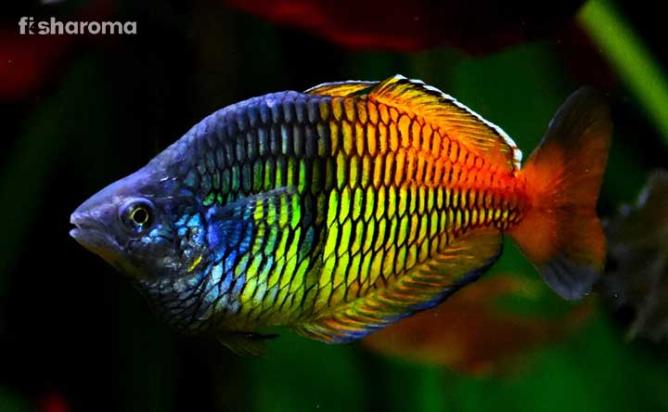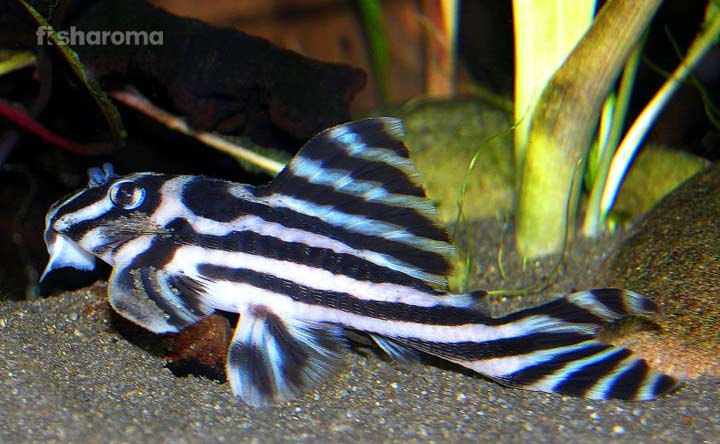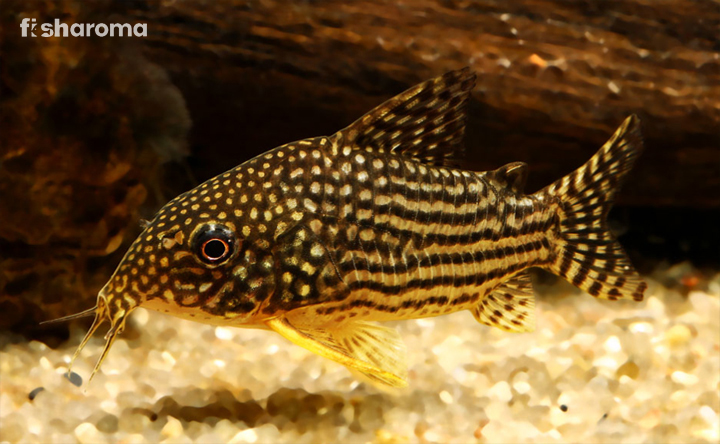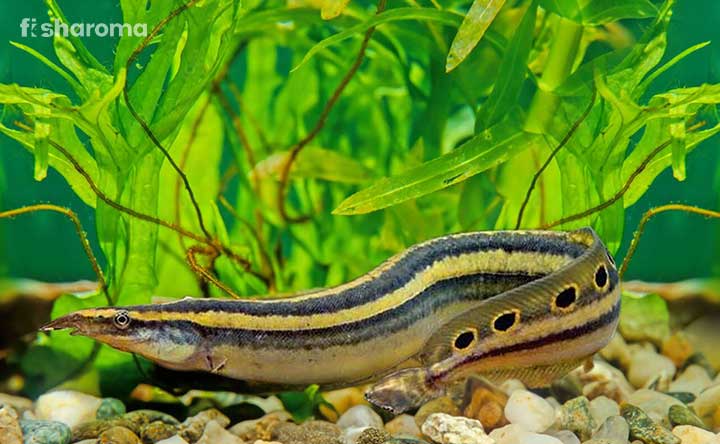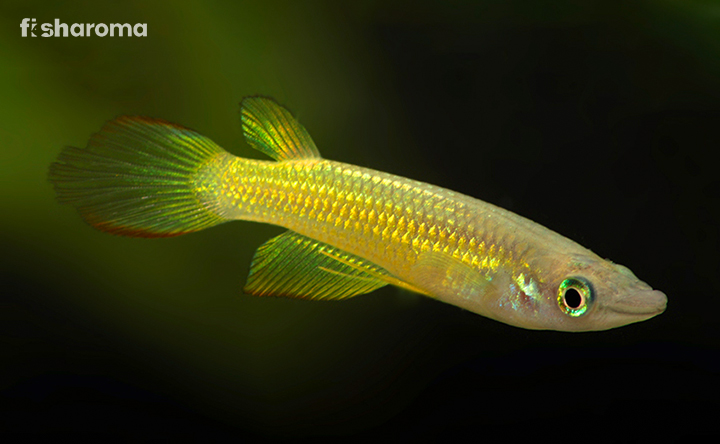German Blue Ram Complete Care Guide: Brightly-Colored Cichlid for Your Aquarium
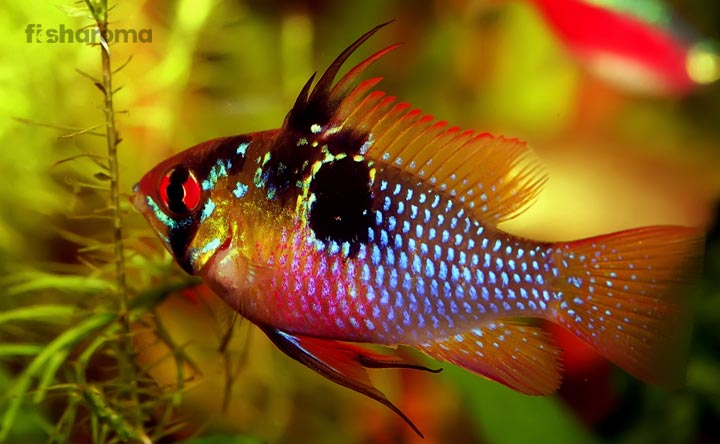
- Origin & Habitat of German Blue Ram
- Appearance of German Blue Ram
- Behaviour of German Blue Ram
- Lifespan of German Blue Ram
- Diet of German Blue Ram
- Tank Requirements for German Blue Ram
- Water Type for German Blue Ram
- Compatibility of German Blue Ram
- Breeding of German Blue Ram
- German Blue Ram Diseases
- Summary
Isn’t it rewarding coming back to your home from a day of hard work to see brightly-colored fish swimming in your aquarium? Yes, we know the feeling! This is why we are bringing for you the care guide of one such species – German Blue Ram. Now, although they are not the most beginner-friendly fish, their peaceful demeanor more than makes up for it. Interested? Let us find out more about them.
Key Specifications of German Blue Ram
Take a look at some of the key specifications of German Blue Ram which will help you in getting a fair idea of what you are about to deal with.
| Scientific Name | Mikrogeophagus ramirezi |
| Family | Cichlidae |
| Origin | South America |
| Size | 2-3” (5.0-7.6 cm) |
| Color | Multi-color |
| Care Level | Intermediate |
| Lifespan | 2-4 Years |
| Temperament | Peaceful |
| Compatibility | Low |
| Tank Size | 10-Gallon |
| Diet | Omnivore |
Overview
A member of the Cichlidae family, German Blue Ram is small, colorful fish with a non-aggressive temperament. They do have a rigid living condition, which is why they are not recommended for beginners.
They were first discovered in the year 1948 by George S. Myers and R. R. Harry. Initially, they were scientifically called Paplilochromis ramirezi and then Apistogramma ramirezi. However, their name has since then been changed to Mikrogeophagus ramirezi. Some of their other common names are Ramirezi, Dwarf Cichlid, Butterfly Cichlid, Singapore Ram, and Blue Ram.
The color variants among the different breeds of this species have also generated different names for them, such as Electric Blue Ram Cichlid, Golden Ram, Gold German Ram, Asian Ram, Balloon Ram, etc.
Origin & Habitat of German Blue Ram
Native to South America, German Blue Ram have their homeland in the Amazon River, especially in the Orinoco River basin in the Los Llanos of Venezuela and Colombia.
In the wild, they are mostly seen in slow-moving water of shallow streams and pools that are dominated by thick vegetation and sandy substrates. The water can range anywhere from crystal clear to dark ‘tea’-colored.
Los Llanos is a Spanish term that translates to “the flat plains”. Here, it refers to the vast area of tropical grassland plain that is located east of the Andes Mountains in north-western South America.
Appearance of German Blue Ram
German Blue Rams have an oval-shaped body and pointed fins and tails. Sexual dimorphism is apparent in them through their dorsal fins, which are more pointed in males than females. The body shapes of females are also plumper than that of the males and their tailfin has a round edging to them.
Similar to all other Cichlids, German Blue Rams also have a well-developed pharyngeal set of teeth in their throat alongside their regular set of teeth. They also have a nostril on each side.
The back parts of their pectorals, anal, pelvic, and dorsal fins have spiny rays that save them from the attacks of predators. Since the frontal portion of their fins are soft and build for ensuring precise positions, German Blue Rams are known for their effortless, graceful movements in the water than their fast swimming.
Size of German Blue Ram
They are one of the smallest Cichlids that you can host in your aquarium, growing up to 2” (5.0 cm) in captivity, although, in the wild, they can grow slightly longer at 3” (7.6 cm). Males tend to be a bit larger than their female counterparts.
Color of German Blue Ram
The magnificent appearance of German Blue Rams is due to their brightly-colored bodies. Usually, their body is yellowish-green with blue dots all over that extend to their dorsal, caudal, and anal fins. They also sport seven vertical dark stripes on their flanks. There is one prominent vertical stripe that runs downwards across their heads through their eyes.
To put it more specifically, the first third of their body is yellow in color starting from the nose, while the last two-thirds are bluish-white.
When kept in captivity, these stripes become vaguer. There are red patches on their bellies and the area near their eyes. In females, the bellies are pinkish-orange. The dorsal fin is in yellow color, while the pelvic fins are red and blue in color. The upper and lower lobes of the tail fin and dorsal fins are also red. The first few rays of their dorsal fins have a black blotch in them.
Behavior of German Blue Ram
In sharp contrast to the other members of Cichlidae, German Blue Rams are peaceful. They spend the majority of their time swimming around. However, this doesn’t mean that they don’t like hiding. They are on the “more bark than bite” end of the spectrum.
Lifespan of German Blue Ram
How long German Blue Rams live clearly depends on how well they are taken care of. An individual living in a natural habitat will obviously live longer than someone who is living in a captive environment with suboptimal conditions.
They are one of the shortest living aquarium species, living only up to 2-4 years. However, few individuals have been known to live longer, although it is extremely rare.
Diet of German Blue Ram
These freshwater creatures have an omnivorous diet and survive on small organisms and plant matter in the wild. Although they are open to eating pellets and flakes, try not to make these foods part of their staple diet.
Instead of feeding them one large portion in a day, feed them 2-5 small portions of food every day. Provide them that much food in a single session which they can consume in 2-3 minutes. Any leftover food must be picked up in order to avoid water contamination.
In an aquarium setup, you can feed the following food items to them:
- Bloodworm
- White Worm
- Chopped Earthworm
- Artemia/ Brine Shrimp
- Cyclopleeze
- Live Mosquito Larvae
- Blanched Vegetables
You can provide a live or frozen version of these aforementioned foods. Live food help in ensuring the brightness of the colors in their bodies.
Remember, when they are first introduced to the tank, they often lose their appetite and are seen refusing to eat. This is completely normal and your Ram will start eating as soon as they are accustomed to the new environment.
Tank Requirements for German Blue Ram
Let us take a look at the various housing requirements for this freshwater species.
Tank Size
German Blue Rams fall under the small aquarium fish category. As such, you wouldn’t require a large tank for them. For a single specimen, a 10-gallon tank will be sufficient, and with each Ram that you introduce to the tank, provide 10 gallon space for them.
Tank Lid
Always use a tank lid since it will help in protecting the water and also in keeping your fish safe from children and pet dogs or cats if you have one.
Substrate
In their natural habitat, they spend a lot of time sifting through the substrate looking for small organisms and plant matter. Thus, you have to ensure that the substrate you choose must be soft and safe enough for them to sift through.
Sand-based substrates with small non-sharp gravels are ideal for them. However, don’t use aragonite sand (also known as “Cichlid sand”) since it is made of calcium carbonate, and it will increase the pH level of the water.
Nature of Lighting
The lighting inside a German Blue Ram aquarium should be moderate to low since it will mimic its natural environment.
Filter
These freshwater Rams live in slow to moderate moving water. So, pick up a filter that can get the same job done. The filter must also be efficient enough to clear out the leftover food and wastes produced by the Rams.
The water should also be well-oxygenated in order to maintain the health and color of your fish.
Ornaments
You can feel free to include caves, castles and other types of aquatic decorations in your tank because German Blue Rams love hiding. Rocks and driftwood are also great options for decorating the tank. Just make sure that they don’t have any sharp edges.
Presence of Flora
In the wild, these Rams live in an area that is dominated by thick vegetation. So, don’t shy away from introducing plants in your tank. Having said that, don’t clutter your tank with these plants; else it will block the swimming space of your Ram. Acid-tolerating plants are most suited for German Blue Ram tanks.
The ideal plants that you can keep with your German Blue Ram are as follows:
- Java Fern
- Water Wisteria
- Amazon Sword Plant
- Rosette Plant
- Jungle Vallis
- Stem Aquarium Plant
Keeping Bogwood in the tank will help in bringing out the exact color of the water that is found in the water of the South American Rivers where these fish reside.
Don’t forget to cycle your tank before introducing the German Blue Rams. The cycling should take place at least a couple of weeks beforehand since it will take time for the beneficial bacteria to form their colonies.
Cleaning Method
Cleaning the tank on a monthly basis ensures that the environment inside the tank is healthy. Keep in mind not to use any harsh chemical or soap-based products to clean the interiors of the tank as the residue of the soap or chemical may remain even after a thorough wash.
Simply take lukewarm water and use it to wipe off the interior walls with a soft cloth. As far as the substrate is concerned, you can use a siphon to vacuum it and the rest of the ornaments can be put under running water to clean them. Also, scrape off algae as much as possible.
Water Type for German Blue Ram
Next up, it is time for you to find out the type of water you need to provide for these fish. Regular tap water can be used if it doesn’t have a huge dosage of chlorine or iron. In that case, it is recommended to use Reverse Osmosis (RO) water.
Temperature
The temperature of the tank water should be maintained between 78-85° F (25.6-29.4° C). If your heater doesn’t come with a reading temperature facility, installing a submerged thermometer in the tank will help you keep a track of the temperature round the clock.
pH Level
The pH level of the water should be slightly acidic to neutral at 6.0-7.5.
Hardness
The general hardness should be 6-14 dGH.
Mineral Level
General Blue Rams are a delicate species. If the wastes produced by the fish and leftover foods are not cleaned on a regular basis, then it can lead to an abundance of ammonia (NH3), which is really toxic. Even 1 ppm (part per million) ammonia can kill them.
Thus, install a good filter in your tank and regularly replace the tank water. More about this has been explained in the next sub-heading.
Replacement Procedure
As you have just read in the above point, the rise of ammonia can be extremely deadly for your German Blue Rams. Not regularly changing the water is a major reason behind it. Therefore, pick a schedule from the following table for your tank water replacement.
Remember, you need to pick only one of the following schedules. Too frequent replacement of the tank water or replacing the entire tank water altogether will kill off the beneficial bacteria that are needed to breakdown ammonia into nitrite, which then turns into nitrate. Therefore, you can:
- Replace 10% of the tank water every week, or;
- Change 20% of the tank water every 15 days or;
- Replace 40% of the tank water every month.
Compatibility of German Blue Ram
German Blue Rams can be either kept alone or in pairs. If you decide to keep more than one male together in a tank, make sure there is a large enough space in your tank.
Suitable Tankmates for German Blue Ram
They are well-suited for community tanks. You can keep them with both Cichlids and non-Cichlid species. Just bear in mind that the environment will have to be peaceful since they would struggle in an aggressive tank. In other words, keep them with small, peaceful freshwater species. Non-fish pets can also be kept in their tank as long as they aren’t too small to fit in the mouths of your Ram.
The ideal tankmates for a German Blue Ram are as follows:
- Silver Dollar
- Kuhli Loach
- Clown Loach
- Discus
- Rainbowfish
- Rummy-Nose Tetra
- Black Phantom Tetra
- Glowlight Tetra
- Cardinal Tetra
- Neon Tetra
- Corydoras Catfish
- Plecostomus Catfish
- Platy
- Molly
- Guppy
- Dwarf Gourami
Unsuitable Tankmates for German Blue Ram
Avoid keeping German Blue Rams with large and aggressive species such as Green Terror Cichlid.
Breeding of German Blue Ram
Being the open spawners that they are, German Blue Rams lay 150-200 eggs after forming a family group in the wild. When kept in captivity, it is advised to let juveniles pair themselves up. You can help them do so by hosting 6-8 juveniles in your tank and finding out which are the pairs among them by figuring out which two spend the most time together.
Prepare a separate breeding tank, where the reproduction process will take place. The temperature of the tank water should be 77.0-82.4° F (25-28° C) and there should be an ambiance of “night light” for the evening. You also need to provide wide leaves and smooth pebbles for them to spawn on.
You will notice the pair continuously cleaning the top of the pebbles before spawning. This will be followed by the female laying numerous oval eggs orange in color. The males will then fertilize those eggs externally. Both the male and female parents take in the responsibility of fanning and watching over the eggs.
The eggs hatch in the next 60 hours and in a few days, the fries are able to freely swim. Females generally move the fries to a pit somewhere in the tank that they dug before.
After Care
If you notice the male parent attacking the female, remove the male from the tank. It is not uncommon for both the male and female parents to separate the fries into their own broods. The males “clean” the fries by engulfing and then spitting them out. When you notice the yolk sac disappearing from the fries, provide them other food options such as Infusoria or microworm meal or even baby Brine Shrimp.
You need to replace 10% of the tank water daily in the breeding tank and make sure the water parameters remain unchanged, as in, the new batch of water should have the same temperature, pH level and hardness as that of the existing batch of water in the tank. There is a black blotch on the sides along with blue spangle dots in female juveniles while in case of male juveniles, the dots are missing.
After around three weeks, you can remove the male parent from the breeding tank and conduct a 50% water replacement with RO water for the spontaneous growth of the fries.
German Blue Ram Diseases
Low oxygenation, poor quality of the water, and stress make these freshwater species highly susceptible to various diseases. They are also highly sensitive and can’t tolerate random changes to the water parameters.
As with any other freshwater fish, German Blue Rams also suffer from Ich every now and then. You can treat this by slightly increasing the temperature of the tank water to 86° F (30° C) for three days and then reverting back to normal.
Apart from Ich, the other common diseases that strike a German Blue Ram are as follows:
- Costia disease
- Cestoda infestation (Tapeworms)
- Metacercaria infection (Flatworms)
- Parasitic infestations (Protozoa)
- Turbidity of the skin
- Tuberculosis (Piscine)
Get immediate help from veterinarians and don’t just rely on home remedies. The sooner the treatment starts, the better it will be for the health of your fish.
Interesting Facts about German Blue Ram
- German Blue Rams derive their name Ramirezi from Manuel Ramirez, who was one of the first collectors and importers of this fish for the aquarium trade.
- They “smell” water by gulping water and throwing it right back after “testing” it for a period of time.
- The colors of the German Blue Rams intensify during spawning.
Summary
German Blue Rams are a fascinating species and are among the smallest freshwater pets that you can have. They are intolerant of changes in their nearby vicinity. So, you have to be careful with them. When it comes to breeding them, it is quite hassle-free.
The peaceful demeanor of German Blue Ram helps them integrate well with other small, peaceful species. As such, they are regarded as great additions for community tanks as well.
Care Guides of Similar Freshwater Fish
If you want to dig deep into the care guides of other freshwater fish, then these following articles might come in handy for you. Have a look at them.
- Firemouth Cichlid – Although docile, these harmless species do display aggression every now and then due to their territorial nature.
- African Cichlid – One of the most colorful groups of Cichlids in the world, they are highly intelligent.
- Bolivian Ram – A member of the Cichlid family, they will keep you intrigued with their amusing behaviors.

